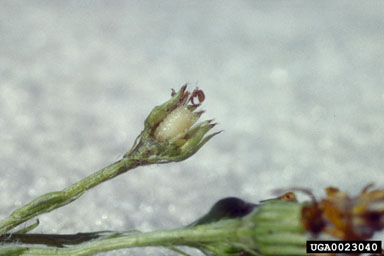Pegohylemyia seneciella
Insect: fly (Diptera Anthmyiidae)
ragwort seed fly
Eric Coombs, Oregon Department of Agriculture, Bugwood.org
http://www.invasive.org/browse/detail.cfm?imgnum=0023040
Origin: These flies originated in France (1).Life Cycle:
Over wintering State: This insect over winters as a pupa (1).
Egg Stage: The eggs are laid on ragwort flowers in the early summer or late spring (1).
Larval Stage: Larvae are white colored and are 4-6 mm long. They come out of the egg usually during April or May, but can emerge as late as July in high altitudes. The larvae dig into the flower buds and eat the seed heads (1).
Pupil Stage: The pupil stage begins in either August or September and lasts through the winter. This stage takes place under the soil. The pupa are dark brown and are usually about 5 mm in size (1).
Adult Stage: The adult seed flies come out of their pupil cases in the spring and resemble house flies. They are 5-7 mm long (1).Damage to Host: Pegohylemyia seneciella larvae attack the flower receptacle of tansy ragwort, destroying almost all of the seed and seed heads (1).
Impact on Host: Since the larvae eat the seeds, the reproduction of tansy ragwort is slowed down (1).
Favorable Release Habitats: Pegohylemyia seneciella prefer meadows and clearings in forests. Forest areas that are heavily shaded cause the insect to not do very well (1).
How to Collect, Transport, and Release: It is best to collect the infested plants with the larvae in them, or to use a sweep net to collect the adults. It is easy to collect the adults early in the summer. Pegohylemyia seneciella should be transported in the larval stage or sometimes the adult stage (1).
How to Redistribute: One way in redistributing the insects is to harvest the infested weeds near the end of the summer. The stems of the plant should be kept in a bucket of water with the flowers held over an area of sand. The larvae will emerge from the flowers and drop into the sand to pupate. The sand should be kept cool and placed in a cage or in a field during the spring so the adults can emerge and infest a new area. Also, adults can be redistributed by collecting them on the plants during dawn while it is still cold outside. Flies should be stored in a cool, dry place and will live for a week (1).
How and Where to Purchase: No information could be found on purchasing these insects. Check with your local County Weed Coordinator.
Remarks: The Pegohylemyia seneciella flies can distribute themselves, sometimes spreading so quickly that they can find patches of tansy ragwort over 100 km (60 miles) away. This seed fly has been discovered in almost every tansy ragwort infestation in the northwest (1).
Links:
1. Tansy Ragwort
2. Ragwort Seed Fly
3. Del Norte County Tansy Ragwort Biological Control Project
4. Noxious Weeds Control Method Project List
5. How to control Ragwort
6. Information about Tansy Ragwort
7. Controlling Ragwort
8. Information about weeds
9. Information about Pegohylemyia seneciella
10. More Information about Tansy Ragwort
Literature Cited:
(1) Rees, Norman, et. al., Ed., Biological Control of Weeds in the West, Western Society of Weed Science, in Cooperation with USDA ARS, MT Dept. of Ag, and MT State Univ., Color Printers, Bozeman, MT, Feb., 1996.
By: Anna Marx and Jenelle Hanson 01/11/02.
Updated by: Brandon Smith and Evan Lewton 01/30/08.
Back to Biological Control mtwow.org HOME
